|
MICROGRAVITY FLUID DYNAMICS:
USING THE SPACE LABORATORY TO CONDUCT EXPERIMENTS ON FLUIDS SUBJECT TO ROTATION
AND RADIAL GRAVITY
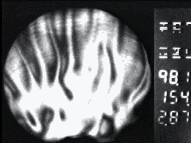
GFFC Experiment on
SpaceLab
Geophysical Fluid
Dynamics Laboratory, Univ. of Colorado
This research is funded the National Aeronautics and
Space
Administration, Division of Microgravity Science and Applications.
FERROMAGNETIC FLUID DYNAMICS EXPERIMENTS ON
STRATIFIED SHEAR FLOWS
The Taylor-Couette experiment is a
famous classical laboratory system in fluid dynamics. A constant density fluid is
contained between differentially rotating cylinders, and almost a hundred years
of studies of the instabilities and turbulence in this system has led to
significant advances in our understanding of the complex and intriguing behavior
that develops in the fluid held between the two cylinders. With support
from NASA we are developing a new generation of experiments that generalize
Taylor-Couette system in a significant way. A
ferromagnetic fluid is used between the cylinders, and a stack of strong
magnetics is placed, in a special configuration, down the axis of the
cylinder. The magnetic field generates a weak body force that is directly
proportional to temperature, just like gravitational buoyancy. This force
is radial and so the Ferromagnetic Taylor-Coutte system with walls maintained at
different temperatures will permit study of stratified shear flow instability
and turbulence. An experiment is being designed for flight on the space station, where
the relatively strong terrestrial gravity will not interfere with the
artificially generated radial gravity.
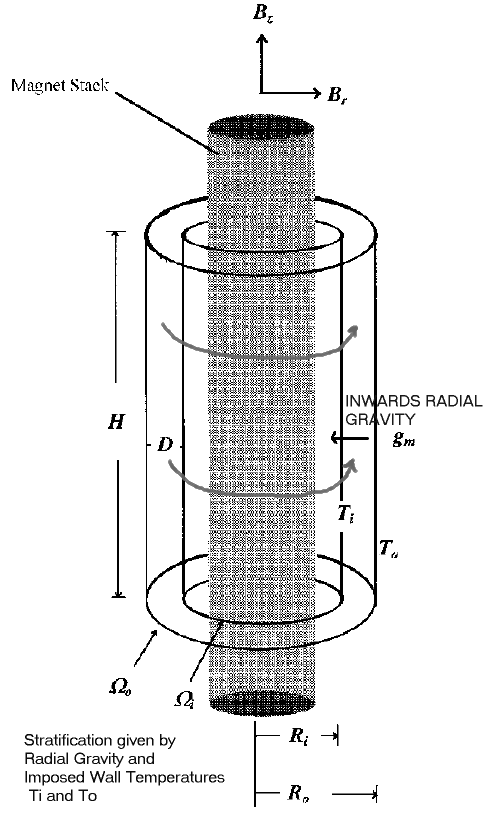
Schematic of the proposed Ferromagnetic Taylor Couette Experiment. The
inner and outer cylinders rotate, imparting a shear V(r) to the fluid in
between. The magnet stack generates a radial gravity gm directed
inwards. Coupled with a temperature distribution T(r) set up by
maintaining the inner and outer cylinders at different temperatures, the basic
axisymmetric fluid state constitutes a stratified shear flow. This shear
flow may become unstable in many different ways depending on the parameter
settings. Studies of these instabilities and the transition to turbulence
in this system will help us better understand geophysical situations where shear
interacts with convection, or where shear instabilities are affected by a stable
stratification.
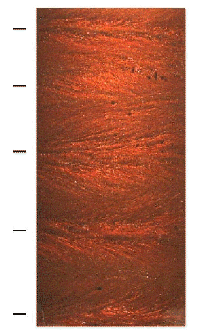
Visualization of cells and small-scale turbulence in a non-stratified Taylor-Couette
cell filled with ferromagnetic fluid. Small non-magnetic aluminum flakes
imbedded in the fluid allow tracking of near surface features. This view
is taken looking in at the side of a tall cell.
The Proposed Ferromagnetic
Taylor-Couette Experiment is an outgrowth of the successful
dielectric convection experiment carried out by our group in the mid-80's to
mid-90's. The following article, written by Dave Dooling at the Marshall
Space Flight Center, describes the Geophysical Fluid Flow Cell Experiment
that was used to model rotating convection on spherical planets with radial
gravity distributions.

Space Science News home
|
"Planet in a test tube" yields hints
about planetary circulation
NASA publishing results
from Geophysical Fluid Flow Cell experiments
|
|
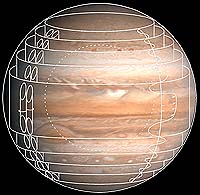 Aug.
10, 1999: What do the racing winds on Jupiter and the snail's pace
circulation of molten rock inside the Earth have in common? They're all
fluids whose movements were simulated in a "planet in a test
tube" flown aboard the Space Shuttle in 1985 and 1995. Aug.
10, 1999: What do the racing winds on Jupiter and the snail's pace
circulation of molten rock inside the Earth have in common? They're all
fluids whose movements were simulated in a "planet in a test
tube" flown aboard the Space Shuttle in 1985 and 1995.
Hubble image of Jupiter with possible
convection patterns outlined in white. The dotted line represents the
approximate location of the hypothesized transition zone between neutral
and metallic hydrogen in Jupiter.
Since the early 1900s scientists have used rotating pans filled with
liquids to simulate the flow of Earth's atmosphere. In the last few
decades researchers have increasingly used advanced computers to
simulate atmospheres and interiors of stars and planets. But even these
computer models have been limited by the complexity of the equations
that described fluid motions in these objects.
To complement the computer simulations, a team of scientists took a
physical laboratory model of stars and planets into space where
weightless conditions prevail, and then gave it an artificial radial
gravity (meaning it pulled inward towards the center of the spherical
test cell) just as found on these objects.
|
|
One striking finding indicates that
the present circulation in the Earth's mantle may not be the only one
that could have resulted when it formed. Small variations in conditions
at the start of an experiment simulating the mantle can lead to
different end environments that seem to resist further change.
 Enlarged
16mm movie frame from first GFFC flight shows flow patterns as revealed
by density changes in the oil. Numbers on each side record experiment
conditions. Credit: University of Colorado at Boulder. Enlarged
16mm movie frame from first GFFC flight shows flow patterns as revealed
by density changes in the oil. Numbers on each side record experiment
conditions. Credit: University of Colorado at Boulder.
"An interesting discovery is that you can get multiple flow
regimes by starting from the same external conditions like rotation and
heating," said Dr. John Hart of the University of Colorado in
Boulder. He is the principal investigator for the Geophysical Fluid Flow
Cell (GFFC), which NASA called a "planet in a test tube," that
flew twice on the Space Shuttle. It was designed to model Earth's
climate and interior, the Sun's atmosphere, and the atmospheres of gas
giant planets. Results are being published in a NASA Technical
Memorandum.
The GFFC was sponsored through NASA's Marshall Space Flight Center as
part of the Microgravity Research Program.
The first flight of the GFFC on Spacelab 3 (STS 51-B; April 29-May 6,
1985) was highly successful. More than 100 hours of experiment runs were
conducted, and 50,000 16mm film images were recorded. These showed
examples of convection structures, instabilities, and turbulence to be
expected in a rotating spherical shell of fluid subject to radial
gravity and a range of different heating and conditions of rotation.
Continues after sidebar |
|
Putting a planet in a test tube
Building physical
models of the atmosphere dates to the early 1900s. Scientists
filled pans with water and a visible tracer and then rotated the
pans to simulate the flow of air around the Earth. While
these models provided insight into basic features of atmospheric
flows, the models had the same problems as maps of the Earth:
they flatten a three-dimensional, spherical world into a
distorted, rectangular view.
Supercomputers and then
high-power workstations helped get around the problem in the
1960s and '70s, but even these had limits. This led Hart to
propose a scale model, the GFFC, in which they could simulate
selected portions of global circulation in space, without
gravity making warm fliud settle to the bottom and warm rise.
The heart of the GFFC is a
nickel-coated, stainless-steel ball, about the size of a
Christmas ornament, under a synthetic sapphire dome. Silicone
oil between the two plays the part of the atmosphere of Jupiter
or the Sun, or of Earth's molten mantle, all depending on
experimental conditions. The rest of the GFFC comprised a
temperature-controlled turntable to spin the dome, and a complex
optical system to take pictures of the fluid flow patterns.
Finally, the GFFC used an
electric charge between the sphere and dome to serve as
artificial gravity pulling the oil towards the center of the
dome so warm and cold would circulate from the brass sphere to
the sapphire dome and back. As the dome rotated, the science
team hoped it would set up circulation patterns like those
inside Jupiter, the Sun, and Earth.
Two optical techniques let
scientists see the flow patterns. Density differences between
the warm and cold fluid made the fluid itself act as a lens that
would produce areas of shadow or brightness. Alternatively, an
ultraviolet flash lamp behind a pinhole mask would darken a
light-sensitive dye in the fluid. These spots would go with the
flow.
The "planet" inside
the GFFC. The white ceramic base shows the depth of the silicone
oil "atmosphere" that filled the space between the
sphere and the sapphire dome.
Data came from a 16mm film
cameras carried on both missions and a solid-state TV camera
added for the second mission.
|
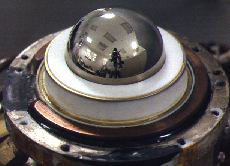
Above is the steel ball that
played the part of a planet or stellar core (depending on the
simmulation conditions) at the heart of the GFFC (shown below
in a cutaway drawing).
 |
|
|
Before the flight "there was a
question of whether you could get convection patterns and wind
distributions that resembled those on a gas giant planet," Hart
recalled. The question was answered with several new observations,
including "banana cells," rapidly rotating columns that formed
as differential heating was increased. Subsurface "banana
cells" are believed by some scientists to be a key feature in the
atmospheric structure of Jupiter. Many of these phenomena were not fully
investigated during the Spacelab 3 mission because of time limits on the
experiments. Further, scientists could not observe events as they
unfolded - the GFFC used 16mm film in its first flight - and thus could
not interact with the experiments.
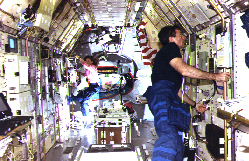 Left:
Fred Leslie at work aboard USML-2. Credit: NASA/Marshall. Left:
Fred Leslie at work aboard USML-2. Credit: NASA/Marshall.
"The first flight of the GFFC was a little like running an
experiment in the lab with the lights off," said Dr. Fred Leslie, a
GFFC co-investigator working in the Science Directorate at
NASA/Marshall. "We had no indication how the fluid was responding
to the inputs. On the second flight, not only did we have a real-time
video camera to observe the flows, but we also had a computer interface
through which the crew could interact with the experiment."
Results from the first flight were significant enough to warrant a
followup flight on the U.S. Microgravity Laboratory-2 (STS-73; Oct.
20-Nov. 5 1995). They also appeared in the cover of Science
magazine in late 1985.
Now equipped with a TV camera so scientists could observe and modify
experiments in real-time, the GFFC carried out 29 separate 6-hour runs.
Many of these were conducted by Leslie who flew as a payload specialist.
|
|

Video frames from the second GFFC flight on USML-2. At right is a solar
model case. The equator is at the top, and the pole is at the bottom.
The features propagate prograde at the bottom and top of the frame,
while moving retrograde at mid-latitude. The middle image shows a stable
polygonal convection pattern. As the rotation rate of the cell is
increased from the conditions of the middle image, columnar convection
modes appear (right). Credit: NASA/Marshall
|
|
One of the findings from the second mission is that long-term evolution
of convecting flows in slowly rotating spherical shells (perhaps
resembling conditions in the Earth's mantle) depends on initial
conditions.
"Even under the same external
driving, like rotation and heating, small variations in initial
conditions at the start of an experiment can lead to different end
states," Hart explained. The initial variations are caused by
seemingly minor things like starting an experiment with a slightly
different protocol than for a previous run.
The finding confirmed a prediction by Dr. Tim Miller, an atmospheric
scientist the Global Hydrology and Climate Center in Huntsville and a
GFFC co-investigator.
"We designed the experiment for multi-equilibrium states that I
found by accident in my computer models," Miller explained. A
single-equilibrium experiment ends with similar flow patterns regardless
of how you start. A multi-equilibrium experiment ens in different
states depending on how you conduct the experiment.
"In our case, we got different flow patterns depending on
whether we started with weak 'gravity' [the electrostatic pull on the
oil] and ramped up," Miller said, "or starting high and
ramping down." And in some cases they wound up with the same flow
patterns regardless of where they started.
One postflight computer model based on the GFFC results shows a
horeshoe-shaped flow at high latitude. It's actually a break in
downwelling at mid-latitudes where upwelling at lower and high latitudes
link to each other.
|
|
 |
Both of
these two flow patterns, as seen in color-coded temperature fields from
GEOSIM model output, are steady-state flows for the same experimental
parameters. They were obtained by using different initial conditions in
the model. Links to 651x651-pixel, 217K
GIF (left) and 145K
GIF (right). Credit: Dr. Tim Miller, NASA/Marshall & GHCC |
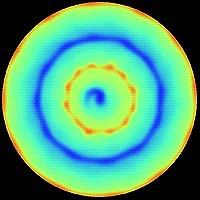 |
|
"An extrapolation of the GFFC results is that different initial
conditions could have led to a different distribution of
continents," Hart continued. "That's speculative, but further
investigation of this sensitivity of low rotation convective patterns to
changes in initial conditions is warranted."
"One can wonder about the relevance of perturbations like this
to the formation of the continents early on planet Earth," Miller
said."Initial perturbations get amplified by the natural
instability associated with these convecting systems" Hart
continued. "These results are interesting, because it means that
the distribution of surface features associated with convection may be
non-unique." On Earth, the continents are thought to move in
response to the steady pull of the viscous mantle beneath the
continental plates.
 Right:
Computer simulation by Anil Deane of the University of Maryland,
College Park and Paul Fischer of Argonne National Laboratory,
corresponds well to images taken during the second GFFC mission. The top
shows a view from the pole, while the bottom shows a view from the
equator. Red corresponds to hot fluid rising while blue shows cold fluid
falling. Credit: NASA/Goddard. Right:
Computer simulation by Anil Deane of the University of Maryland,
College Park and Paul Fischer of Argonne National Laboratory,
corresponds well to images taken during the second GFFC mission. The top
shows a view from the pole, while the bottom shows a view from the
equator. Red corresponds to hot fluid rising while blue shows cold fluid
falling. Credit: NASA/Goddard.
Other results from the second mission include:
- Banded structures in planetary atmospheres like Jupiter and Saturn
were not seen in the GFFC. "It appears that in order to obtain
such multiple jets either experimental conditions far in excess of
those possible in the GFFC, or perhaps even different fluid physical
properties will be required," Hart suggested.
- Several experiment runs using different rotation and heating rates
were used to classify the expected global convection regimes of
planets and stars. These runs included the transition between
"banana convection" - which is oriented north-south, - to
non-aligned convection.
- The experiments showed evidence for baroclinic waves, an
instability where cold, dense masses of fluid slide under warm light
fluid. The GFFC waves are interesting because they combined
attributes of both ordinary thermal convection and rotating
slantwise convection. The latter instability is central to the
circulation of the Earth's atmosphere. Its occurrence as a combined
instability supports recent computational modeling.
- Other experiments with latitudinal heating showed how spiral wave
convection breaks down to turbulence by secondary branching.
The experimental side GFFC project has ended as the scientists have
moved on to other assignments. But the story might not be over.
"There's a lot more science that can be obtained with the data
and the models," Miller said. This includes GEOSIM - the
Geophysical Fluid Flow Simulator - which provides the user with
three-dimensional, nonlinear simulations of fluid flow in cylindrical
and spherical domains. Potential applications include atmospheric
dynamics of Earth and other worlds and materials processing.
|
This research is sponsored by NASA: Microgravity Sciences and
Applications Division.
|








 Left:
Fred Leslie at work aboard USML-2. Credit: NASA/Marshall.
Left:
Fred Leslie at work aboard USML-2. Credit: NASA/Marshall.


